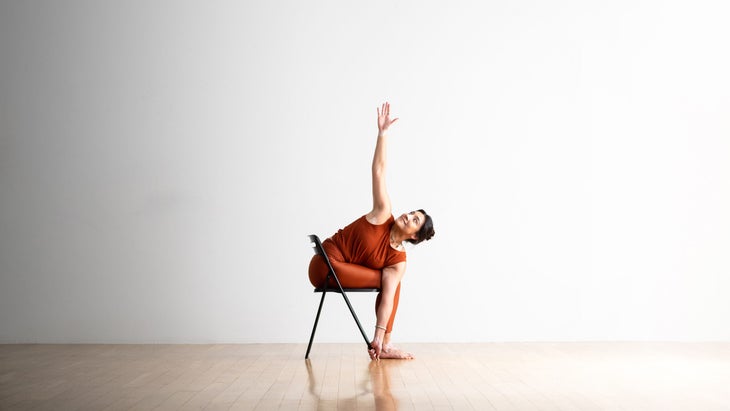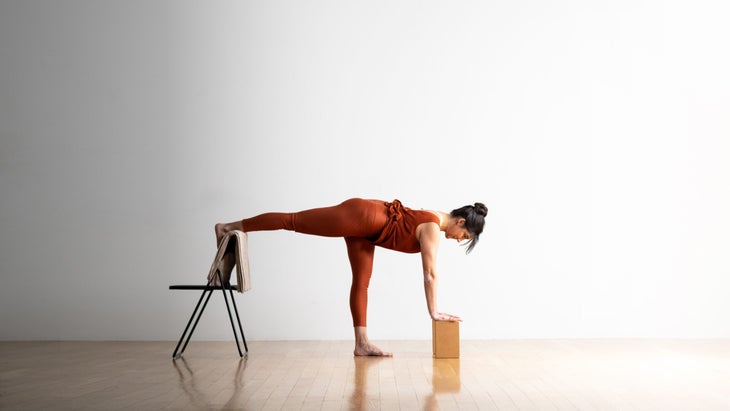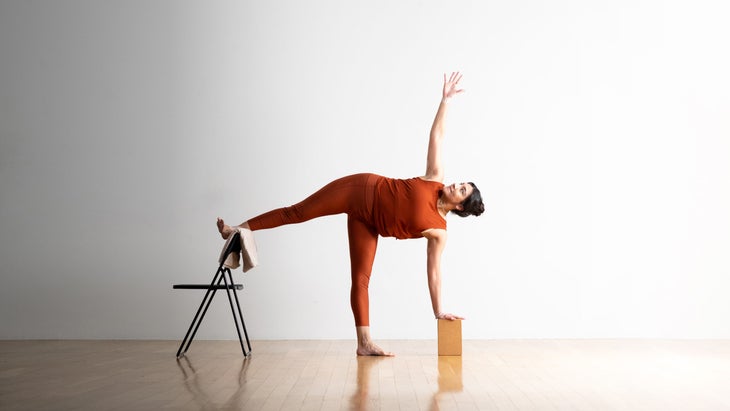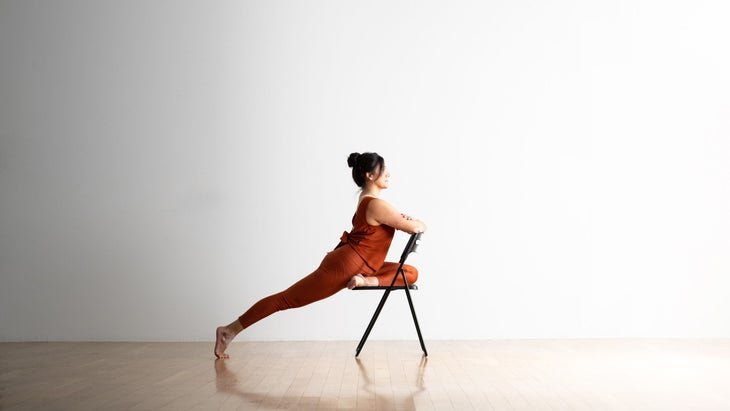Heading out the door? Read this article on the new Outside+ app available now on iOS devices for members!
>”,”name”:”in-content-cta”,”type”:”link”}}”>Download the app.
One of the misconceptions many yoga students (and teachers) find most difficult to shake is that using props indicates lack of ability or effort. Some people see relying on a prop as a synonym for shortcoming–and this may be especially true when it comes to practicing with a chair.
There could not be a more erroneous assumption. You may be thinking: If we just sit in the chair, where is the effort? Chair yoga can take as much strength and flexibility as any of the poses you would do standing or seated on a mat. Try any pose that requires you to lift or extend your legs, for example, and notice the effort of your thighs and abs, as well as the ability to access a deeper range of motion in your twists.
But who said you have to be sitting down to do chair yoga? Using a flipped chair gives you ways to approach a pose that blocks, blankets, straps, and cushions combined cannot.
Benefits of Chair Yoga
There are all kinds of reasons to use a chair in your yoga practice.
It strengthens proprioception.
Proprioception is your awareness of where your body is in space. Having a chair as a touch point can help you understand the position of your body and how you need to move to enter, hold, and exit a pose. In this way, practicing with a chair can transform your perception of many familiar poses. In Warrior III, for example, using a chair to support either your hands or feet can help you learn to square your hips and shoulders toward the ground while drawing your arms and legs into their sockets.
With the support of a chair, you no longer need to concentrate on your balance, which allows you mental room to think about details like pulling your navel toward your spine, flexing your toes, and squeezing your shoulder blades toward each other.
It helps you experience the intended benefit of the pose.
Working with a chair may allow you to get into a pose or stay in it longer than usual. It may help you experience the intended alignment of part or all of the pose while safeguarding against injury, and it can aid in injury recovery by preventing overstretching or overexerting.
It gives you confidence.
Incorporating a chair into your asana practice gives you choices about how to enter a pose and how to make it accessible for you. It offers the opportunity to explore a pose more deeply and find different dimensions of it. A chair can help maximize stability. With this kind of support, you may try a version of a pose you had previously ruled out.
It can help you relax into the asana.
Using a chair allows you the luxury of settling into a pose and enjoying the depth of the stretch while also maintaining safe alignment. From a chair, you can explore and unfold the possibilities many poses invite.
Not So Easy After All
Perhaps the most intriguing benefit of counting on a chair as a prop is its versatility. The poses that follow will help you embody elusive yoga shapes that otherwise may seem impossible to enter and difficult to hold. Start looking at a chair more as a toy to add an element of fun to your practice.
Eka Pada Rajakapotasana (Pigeon Pose)
Stand in front of your chair with the seat facing you. Place both hands on the chair back for support, then lift your left leg and position it so the outside of your thigh and shin are on the seat of the chair. Slide your knee forward and through the open back of the chair as you lower your pelvis to rest on the edge of the seat. Square your hips and extend your right leg straight behind you with your toes tucked. You can place one arm on top of the other and rest your forehead on them. Or keep your chest and head upright and make the pose active by pressing your hands against the chair back. When you are ready, press away from the chair back to come out of the pose. Repeat on the opposite side.

High Lunge
Face your chair with the seat facing you. Place both hands on the chair back and position your left foot gently onto the seat. Lowering your hips toward the floor, slide your foot through the open back of the chair, and find the floor with your foot. Lower your left thigh and both hips onto the chair. Extend your right leg straight behind you and tuck your toes. Rest your arms on top of one another, or keep the upper body active by pressing your hands against the back of the chair. Alternately, you can raise your arms alongside your ears and stay here or take a backbend. Try pressing into both feet and lifting your hips an inch off the chair and notice how that becomes spicy very quickly. When you are ready, come out of the pose and repeat on the opposite side.

Utkatasana (Chair Pose) With a Twist
Sit on the chair as you normally would and lean your torso forward, hinging at your hips. Decide whether you will bring your hands into prayer position at your heart or open your arms straight out from your shoulders. Turn your chest to the right to find your twist. Allow your left arm or elbow to fall either in between your legs or outside your right leg. If your arms are extended, your left hand may connect with the lower leg of the chair to further aid the depth of your twist. When you’re ready, unwind and repeat on the other side.

Virabhadrasana III (Warrior III) With Arm Variations
Stand facing the back of your chair. You may want to place a blanket on the chair back for padding. Lift your right leg and place the back of your ankle on top of the chair back. Make any adjustments to your stance so that you can stand with your lifted leg extended straight. If you’re comfortable with the height and position of the chair, take your foot off the chair and turn your back to it. Have two blocks on the floor in front of you (four if you need more height). Place them on any level positioned beneath your shoulders and place your hands on them for a supported Warrior III. Extend your leg straight back and hook the top of your foot on the chair back. Square your hips and shoulders toward the floor. Engage your abdominals and lift your arms parallel to the ground and in line with the rest of your body. Another option is to have your hands at heart center in prayer position. When you are ready, come out of the pose and practice on the opposite side.

Ardha Chandrasana (Half Moon Pose)
Stand at the back of your chair and place a blanket on the chair back if you need padding. Position a block near your left foot. Place your right ankle on the chair back. Make any adjustments to your stance so that you can stand with your both legs extended straight. Keeping your ankle on the chair, internally rotate at your leg so that your toes face left. At the same time, pivot on your left heel so your toes and your body also face left. Lean to your left and bring your fingertips to the block. Stack your hips and your shoulders. Eventually you can play with lifting your left hand off the block. When you are ready, support yourself with the block to take your leg off the chair and return to standing. Set up to practice on the opposite side.

